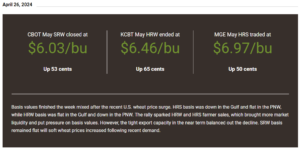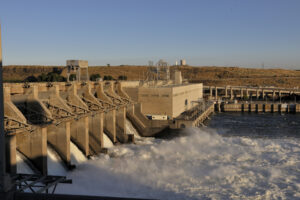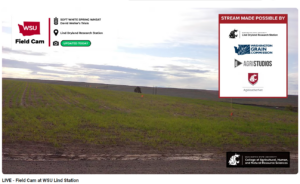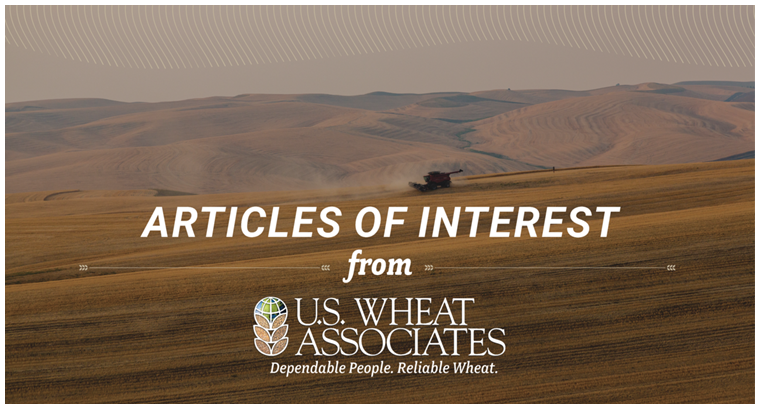Every weekday, U.S. Wheat Associates (USW) searches U.S. and global media for news about the U.S. wheat crop and the world wheat market. USW shares the news of the day as a service to our domestic stakeholders. The articles of interest on Monday, April 29, summarized below also have value for our overseas customers.
Wheat Market Rally
A market analysis article presented April 26 on “Farm Journal AgWeb” reached out to Allison Thompson of The Money Farm to describe a 7-day rally in U.S. wheat futures prices while corn and soybean futures declined. Thompson said concerns about dry conditions in the Central and Southern Plains hard red winter (HRW) region as well as southern Russia and western Canada sparked commercial investors to cover long-held short futures positions.
In the April 26 USW Price Report, Market Analyst Tyllor Ledford related news from traders that the futures rally did prompt farmers to sell old-crop wheat. Storms from April 26 to 28 sadly included a deadly, destructive tornado outbreak but also significant rain for some HRW and SRW production regions. So, early on April 29, HRW and soft red winter (SRW) futures were down. The precipitation missed much of western and south-central Kansas, eastern Colorado, and western Nebraska, however.

Spring Wheat
Also on April 26, North Dakota Wheat Commission Director of Policy and Marketing Jim Peterson told “Farm & Ranch Guide” that there are both positive and negative price influences for U.S. hard red spring (HRS) wheat.

“On the positive note, it looks like an earlier planting season than a lot of other areas relative to the last few years, so that’s typically yield positive,” he explained. “The reason we’re seeing earlier planting is a lot of areas are abnormally dry to critically dry. If we don’t get a big shift in weather patterns here, we could see some early season moisture stress on the spring wheat region. Then we’ll see what happens with acres. Right now, the forecast is for unchanged total acres nationally, maybe up slightly,” he added.
Despite strong Canadian competition, Peterson said some demand fundamentals support the U.S. spring wheat market. Commercial sales of HRS as of April 25 were 13% ahead of a year ago at 6.40 million metric tons (MMT) and more than USDA’s projections.
Potential Wheat Supply Chain Disruption
Along with the farm and grain handling industries in the Pacific Northwest export system, USW is closely watching the political fight about the potential breaching of four dams on the Lower Snake River. An agricultural media company in the region with a website called AgProud.com published an interview about the debate with Scott Corbitt, General Manager of the Post of Lewiston in Idaho. In the interview, Corbitt describes the value of the port to the region and the overseas customers it helps serve.
U.S. grain handlers purchase wheat from farmers and transport approximately 24 million bushels (0.65 MMT) of wheat by barge through the Port of Lewiston every year, he said, and the companies barge 10% of total U.S. wheat exports through the Colombia Snake River System. Wheat exported from Idaho alone exceeds $300 million annually, Corbitt told AgProud.com. He added that breaching the Lower Snake River dams would result in a huge economic hit for the region disrupt the efficient flow of U.S. soft white (SW), HRS and HRW wheat to export elevators downstream in the Portland area.

Eye on the Crop
“Capital Press” reporter Matthew Weaver recently wrote about how researchers at Washington State University have installed a wheat field camera at the university’s dryland research station in eastern Washington state. The still images taken several times a day of a spring SW wheat field can be viewed online at the research station website and on its YouTube channel.

A spokesperson for the station said the camera is a way for overseas and domestic wheat buyers, as well as non-farmers, to see how the crop progresses and to get more information about sustainable wheat production. The station plans to add short videos about the spring SW wheat crop to the service throughout the growing season and harvest.
The Washington Grain Commission, a long-time USW member organization co-sponsors the “WSU Field Cam.”


